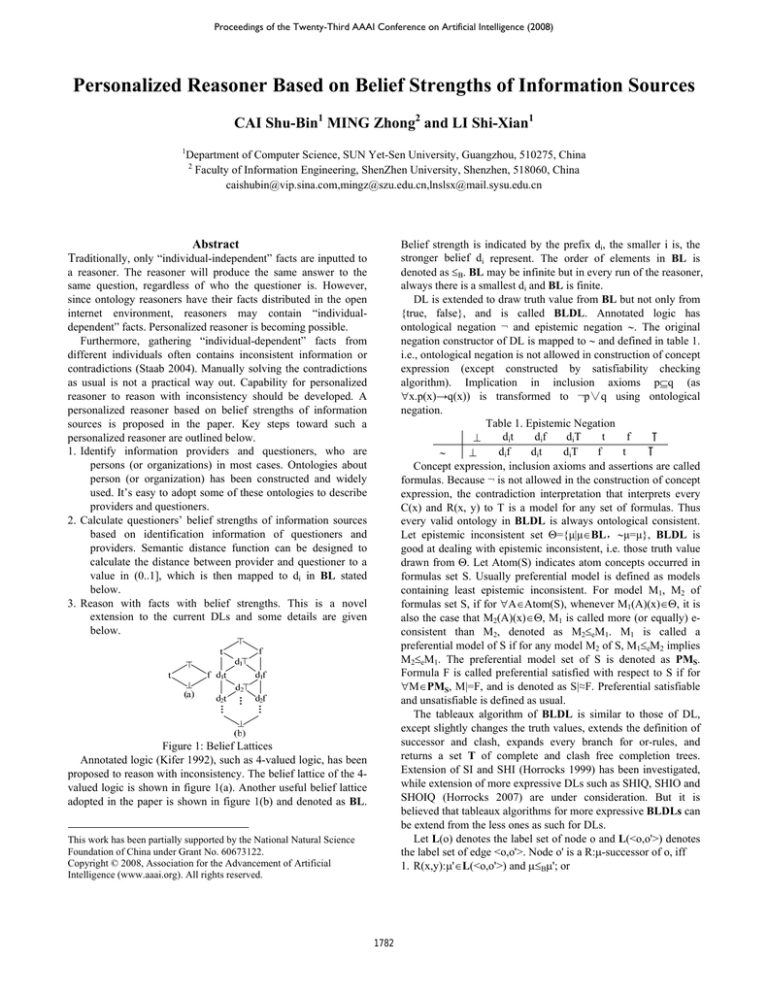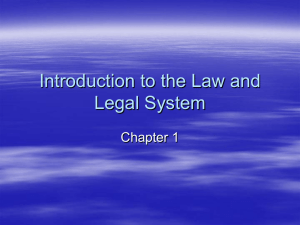
Proceedings of the Twenty-Third AAAI Conference on Artificial Intelligence (2008)
Personalized Reasoner Based on Belief Strengths of Information Sources
CAI Shu-Bin1 MING Zhong2 and LI Shi-Xian1
1
Department of Computer Science, SUN Yet-Sen University, Guangzhou, 510275, China
2
Faculty of Information Engineering, ShenZhen University, Shenzhen, 518060, China
caishubin@vip.sina.com,mingz@szu.edu.cn,lnslsx@mail.sysu.edu.cn
Belief strength is indicated by the prefix di, the smaller i is, the
stronger belief di represent. The order of elements in BL is
denoted as ≤B. BL may be infinite but in every run of the reasoner,
always there is a smallest di and BL is finite.
DL is extended to draw truth value from BL but not only from
{true, false}, and is called BLDL. Annotated logic has
ontological negation ¬ and epistemic negation ∼. The original
negation constructor of DL is mapped to ∼ and defined in table 1.
i.e., ontological negation is not allowed in construction of concept
expression (except constructed by satisfiability checking
algorithm). Implication in inclusion axioms p⊆q (as
∀x.p(x)→q(x)) is transformed to ¬p∨q using ontological
negation.
Table 1. Epistemic Negation
dit
dif
di T
t
f
⊥
T
dif
dit
diT
f
t
T
∼
⊥
Concept expression, inclusion axioms and assertions are called
formulas. Because ¬ is not allowed in the construction of concept
expression, the contradiction interpretation that interprets every
C(x) and R(x, y) to T is a model for any set of formulas. Thus
every valid ontology in BLDL is always ontological consistent.
Let epistemic inconsistent set Θ={μ|μ∈BL,∼μ=μ}, BLDL is
good at dealing with epistemic inconsistent, i.e. those truth value
drawn from Θ. Let Atom(S) indicates atom concepts occurred in
formulas set S. Usually preferential model is defined as models
containing least epistemic inconsistent. For model M1, M2 of
formulas set S, if for ∀A∈Atom(S), whenever M1(A)(x)∈Θ, it is
also the case that M2(A)(x)∈Θ, M1 is called more (or equally) econsistent than M2, denoted as M2≤eM1. M1 is called a
preferential model of S if for any model M2 of S, M1≤eM2 implies
M2≤eM1. The preferential model set of S is denoted as PMS.
Formula F is called preferential satisfied with respect to S if for
∀M∈PMS, M|=F, and is denoted as S|≈F. Preferential satisfiable
and unsatisfiable is defined as usual.
The tableaux algorithm of BLDL is similar to those of DL,
except slightly changes the truth values, extends the definition of
successor and clash, expands every branch for or-rules, and
returns a set T of complete and clash free completion trees.
Extension of SI and SHI (Horrocks 1999) has been investigated,
while extension of more expressive DLs such as SHIQ, SHIO and
SHOIQ (Horrocks 2007) are under consideration. But it is
believed that tableaux algorithms for more expressive BLDLs can
be extend from the less ones as such for DLs.
Let L(o) denotes the label set of node o and L(<o,o'>) denotes
the label set of edge <o,o'>. Node o' is a R:μ-successor of o, iff
1. R(x,y):μ'∈L(<o,o'>) and μ≤Bμ'; or
Abstract
Traditionally, only “individual-independent” facts are inputted to
a reasoner. The reasoner will produce the same answer to the
same question, regardless of who the questioner is. However,
since ontology reasoners have their facts distributed in the open
internet environment, reasoners may contain “individualdependent” facts. Personalized reasoner is becoming possible.
Furthermore, gathering “individual-dependent” facts from
different individuals often contains inconsistent information or
contradictions (Staab 2004). Manually solving the contradictions
as usual is not a practical way out. Capability for personalized
reasoner to reason with inconsistency should be developed. A
personalized reasoner based on belief strengths of information
sources is proposed in the paper. Key steps toward such a
personalized reasoner are outlined below.
1. Identify information providers and questioners, who are
persons (or organizations) in most cases. Ontologies about
person (or organization) has been constructed and widely
used. It’s easy to adopt some of these ontologies to describe
providers and questioners.
2. Calculate questioners’ belief strengths of information sources
based on identification information of questioners and
providers. Semantic distance function can be designed to
calculate the distance between provider and questioner to a
value in (0..1], which is then mapped to di in BL stated
below.
3. Reason with facts with belief strengths. This is a novel
extension to the current DLs and some details are given
below.
B
Figure 1: Belief Lattices
Annotated logic (Kifer 1992), such as 4-valued logic, has been
proposed to reason with inconsistency. The belief lattice of the 4valued logic is shown in figure 1(a). Another useful belief lattice
adopted in the paper is shown in figure 1(b) and denoted as BL.
This work has been partially supported by the National Natural Science
Foundation of China under Grant No. 60673122.
Copyright © 2008, Association for the Advancement of Artificial
Intelligence (www.aaai.org). All rights reserved.
B
1782
2. S(x,y):μ''∈L(<o,o'>), (S(x,y):μ''⊆R(x,y):μ')∈R+ and μ≤Bμ',
where R+ is the transitive-reflective closure of role inclusion
axioms.
Node o is called contains a clash, iff {C(x):μ, ¬C(x):μ', where
μ'≤Bμ,}∈L(o). Expansion rules are modified accordingly. For a
completion tree T, let Pos(T, A)={possible truth value of A in the
root node of T}, Con(T)={A|A∈Atom(T), Pos(T,A)⊆Θ}. T∈T is
called most-consistent if there is no T'∈T satisfying
Con(T')⊆Con(T). The most-consistent completion tree set of T is
denoted as Tmc. T is called a completion tree set of S if the input
formula F of tableaux is null.
Lemma 1. For a formula set S,
1. for ∀M∈PMS, there must ∃TSmc∈TSmc, such that M|=TSmc;
2. for ∀TSmc∈TSmc, there must ∃M∈PMS, such that M|=TSmc.
Proof(sketch).
(condition 1)Suppose M1∈PMS, since S is satisfiable iff the
tableaux algorithm yield a complete and clash-free completion
tree, there must ∃T1∈TS, such that M1|=T1. Condition 1 holds if
T1∈TSmc. Otherwise, T1∉TSmc, there must ∃T2∈TSmc, such that
Con(T2) ⊆Con(T1), i.e., there must ∃B∈Con(T1) and B∉Con(T2),
and M1(B)(x)∈Θ.
A new model M2 is constructed based on Con(T2) and Pos(T2,
A) for ∀A∈Atom(TS), satisfying M2|=T2 and when A∉Con(T2),
M2(A)(x)∉Θ. Because B∉Con(T2), M2(B)(x)∉Θ, and M1<eM2.
Thus M1 is not a preferential model, which contradicts the
assumption. Therefore, condition 1 holds.
(condition 2)Suppose T1∈TSmc, a model M1 is constructed
based on Con(T1) and Pos(T1, A) for ∀A∈Atom(TS), satisfying
when A∉Con(T1), M1(A)(x)∉Θ, and M1|=T1. Condition 2 holds
if M1∈PMS. Otherwise, M1∉PMS, there must ∃M2∈PMS, such
that M1<eM2. Let Con(M)={A|M(A)(x)∈Θ, for ∀A∈Atom(TS)},
obviously Con(M2)⊂Con(M1) and Con(M1)=Con(T1). Since M2 is
a model for S, there must ∃T2∈TS, such that M2|=T2. Because for
∀A∈Con(T2), M(A)(x)∈Θ, A∈Con(M2), Con(T2)⊆Con(M2),
Con(T2)⊆Con(M2)⊂Con(M1)=Con(T1), T1 is not a mostconsistent completion tree, which contradicts the assumption.
Therefore condition 2 holds.
Theorem1. A formula F is preferential unsatisfiable with respect
to a formula set S iff for ∀TSmc∈TSmc, ∀TF∈TF, there
∃A∈Atom(S∪{F}), such that
1. A∈Con(TSmc) and Pos(TSmc, A)∩Pos(TF, A)=∅ or
2. A∉Con(TSmc) and Pos(TSmc, A)∩Pos(TF, A)⊆Θ.
Proof(sketch).
(→)Suppose M is a preferential model for S, from lemma 1,
there must ∃TSmc∈TSmc, such that M|=TSmc. Thus for
∀A'∈Atom(S∪{F}), M(A')(x)∈Pos(TSmc, A'). And M(A')(x)∉Θ
if A'∉Con(TSmc), otherwise M is not a preferential model.
Because for ∀TF∈TF, there ∃A∈Atom(S∪{F}), such that
1. A∈Con(TSmc) and Pos(TSmc, A)∩Pos(TF, A)=∅, then
M(A)(x)∉Pos(TF, A) (because M(A)(x)∈Pos(TSmc, A)), M
can not satisfy TF; or
2. A∉Con(TSmc) and Pos(TSmc, A)∩Pos(TF, A)⊆Θ, since
M(A)(x)∉Θ, M(A)(x)∉Pos(TF, A), M can not satisfy TF.
Thus M can’t satisfy TF. Since M is an arbitrary preferential
model, F is preferential unsatisfiable.
(←)If F is preferential unsatisfiable with respect to S, i.e., for
∀M∈PMS, M|≠F. Suppose there is a TS0∈TSmc, TF0∈TF, such
that no A∈Atom(S∪{F}) satisfies the theorem conditions. A
model M0 is constructed for ∀A∈Atom(S∪{F}) as:
1. if A∈Con(TS0), since Pos(TS0, A)∩Pos(TF0, A)≠∅, there must
∃μA∈Pos(TS0, A)∩Pos(TF0, A)⊆Θ, let M0(A)(x)=μA.
2. if A∉Con(TS0), since Pos(TS0, A)∩Pos(TF0, A)⊄Θ, there must
∃μA∈Pos(TS0, A)∩Pos(TF0, A) and μA∉Θ, let M0(A)(x)=μA.
Obviously M0 is a preferential model of TS0, and a model of TF0.
Thus M0|=F, which leads to a contradiction. Thus the theorem
conditions hold.
From theorem 1, time complexity of preferential unsatisfiable
equals the worst-time complexity of normal DLs. It is decidable
but seems too complex to effort in practical, since expressive DLs
may be as hard as Exp-Time or N-Exp-Time complete based on
the expressivity. But fortunately, we have the following
propositions.
Proposition 1. A model M is a preferential model for a formula
set S if for ∀A∈Atom(S), M(A)(x)∉Θ, i.e., M is an epistemic
contradiction free model for S.
Proposition 2. A completion tree T is a most-consistent tree for a
formula set S if Con(T)=∅.
Proposition 3. A formula F is preferential satisfiable with respect
to a formula set S if there is a TF∈TF, such that Con(T)=∅.
Proofs are straight forward, with notice that these are sufficient
but not necessary conditions.
DL reasoner is said to be practical, as it can stop and answer
“satisfiable”, once a complete and clash free completion tree is
constructed by some optimization means. When there is an
epistemic contradiction free model, which implies a model in the
unextended DL, BLDL reasoner will terminate and answer
“preferential satisfiable” as soon as this model (in fact the
corresponding completion tree) is found. When there is no
epistemic contradiction free model, which means the unextended
DL reasoner should give answer “unsatisfiable” after examining
all possible completion trees at worst-time complexity, BLDL
reasoner will have this worst-time complexity to produce
“satisfiable” or “unsatisfiable” answer. Thus the time cost for
BLDL reasoner is as “practical” as that of DL reasoner.
In a word, BLDL reasoner can produce different answers to
the same satisfiability problem asked by different questioners in a
practical time cost, by annotated formulas with different belief
strengths, which are calculated from the semantic distance
between information providers and questioners.
B
B
References
Staab, S., and Studer, R. eds. 2004. Handbook on
Ontologies. Springer.
Kifer, M., and Lozinskii, EL. 1992. A logic for reasoning
with inconsistency. Journal of Automated Reasoning
9:179-215.
Horrocks, I., Sattler, U., and Tobies, S. 1999. Practical
reasoning for expressive description logic, In Proc. of 6th
Int. Conf. of Logic Programming and Automated
Reasoning (LPAR'99), LNCS1705. pp.161-180.
Horrocks, I., and Sattler U. 2007. A Tableaux Decision
Procedure for SHOIQ. Journal of Automated
Reasoning39:249-272
1783






